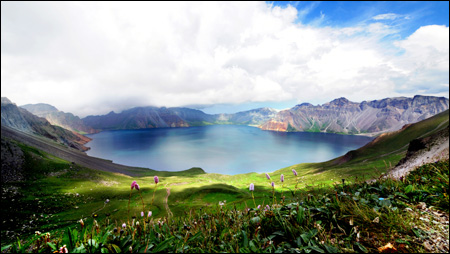
© Korea Times fileCheonji, the crater lake at the top of Mt. Baekdu.
Mountain Baekdu, a dormant volcano on the border between North Korea and China, is showing signs of a possible eruption in the near future, experts warned Tuesday.
"Baekdu could erupt anytime soon," said geologist Yoon Sung-hyo at Pusan National University, who has monitored the nation's highest mountain (2,744 meters) for any changes. "A variety of indicators are backing this scenario. The thing we should try to predict is when. It's clear it's imminent."
The geologist cautiously raised speculation that an eruption could take place in a couple of years.
According to historical records, Baekdu was an active volcano. Major activity in the 1960s created a caldera on its peak, whose circumference is nearly 14 kilometers with an average depth of 213 meters and maximum of 384 meters.
Volcanic ash from this eruption has been found as far away as the southern part of Hokkaido, Japan, according to records.
Small-scale eruptions were recorded roughly on a centurial basis - in 1413, 1597, 1668 and 1702. The latest volcanic eruption recorded at the 2,744-meter mountain was back in 1903.
The mountain has stayed inactive since then, leaving it categorized by scientists as dormant. The Chinese government developed the mountain and surrounding areas as a tourist destination drawing tens of thousands of visitors from around the world each year - many of them from South Korea.
Yet, "unusual signs," including minor trembling among others, began to emerge in June 2002 and a 7.3-magnitude earthquake rattled areas in the vicinity of Baekdu, according to geologists. The frequency of the quakes has notably increased since then.
"It seems that a shockwave from the quake reactivated magma approximately 30 kilometers beneath the mountain," said Prof. Hong Tae-kyung at Yonsei University's department of earth system sciences in Seoul. "The more frequent these are, the higher the possibility of an eruption."
According to a recent TV program based on interviews with officials at a Chinese institute monitoring volcanic activity at Baekdu, minor quakes which are too weak to be felt by human beings take place nearly 100 times per day.
"We saw the number steeply increase in recent years," the program quoted an official as saying. The program showed crumbled stone steps leading toward the top of a scenic waterfall at the heart of the mountain, explaining they recently fell apart due to frequent trembling in the region.
Among other indicators backing the scenario of a future eruption is the height of Baekdu, which has grown nearly 10 centimeters since 2002. Experts say bloated magma, a precondition of eruption, is gradually pushing up the height of the mountain as well as the temperature on the surface.
On October 1, 2006, a Russian satellite found the surface temperature of the mountain notably higher than before. The finding came just days after North Korea conducted an underground nuclear bomb test in its northern region, indicating the test was a catalyst reactivating the magma, analysts said.
The increase in the number of withered evergreen trees on the mountain may be another indicator.
"It was confirmed that pollutants from the surrounding areas are not to blame. If so, toxic gases spewing from the volcano could be a possible culprit," Yoon said.
If the eruption is major in scale, it would bring about massive consequences to the two Koreas as well as the surrounding states, including China, Japan and Russia.
"The amount of volcanic ash from the most violent eruption nearly 1,000 years ago was enough to cover the entire the Korean peninsula to a height of 1.2 meters," he said, citing scientific studies. "Baekdu's caldera contains nearly two billion tons of water. If it evaporates into the air all of a sudden mixed with volcanic ash of a major eruption, it would be blown to the east and consequently engulf Vladivostok in Russia and Hokkaido in northern Japan."
Reader Comments
to our Newsletter